Personal and Professional Development in Finance Field
VerifiedAdded on 2023/06/17
|15
|1247
|77
AI Summary
This presentation discusses the personal and professional development plan in the finance field. It covers the meaning of professional field, description of finance field, types of finance, career path, analyzing career path, strengths, challenges in HR and measures to overcome with them.
Contribute Materials
Your contribution can guide someone’s learning journey. Share your
documents today.
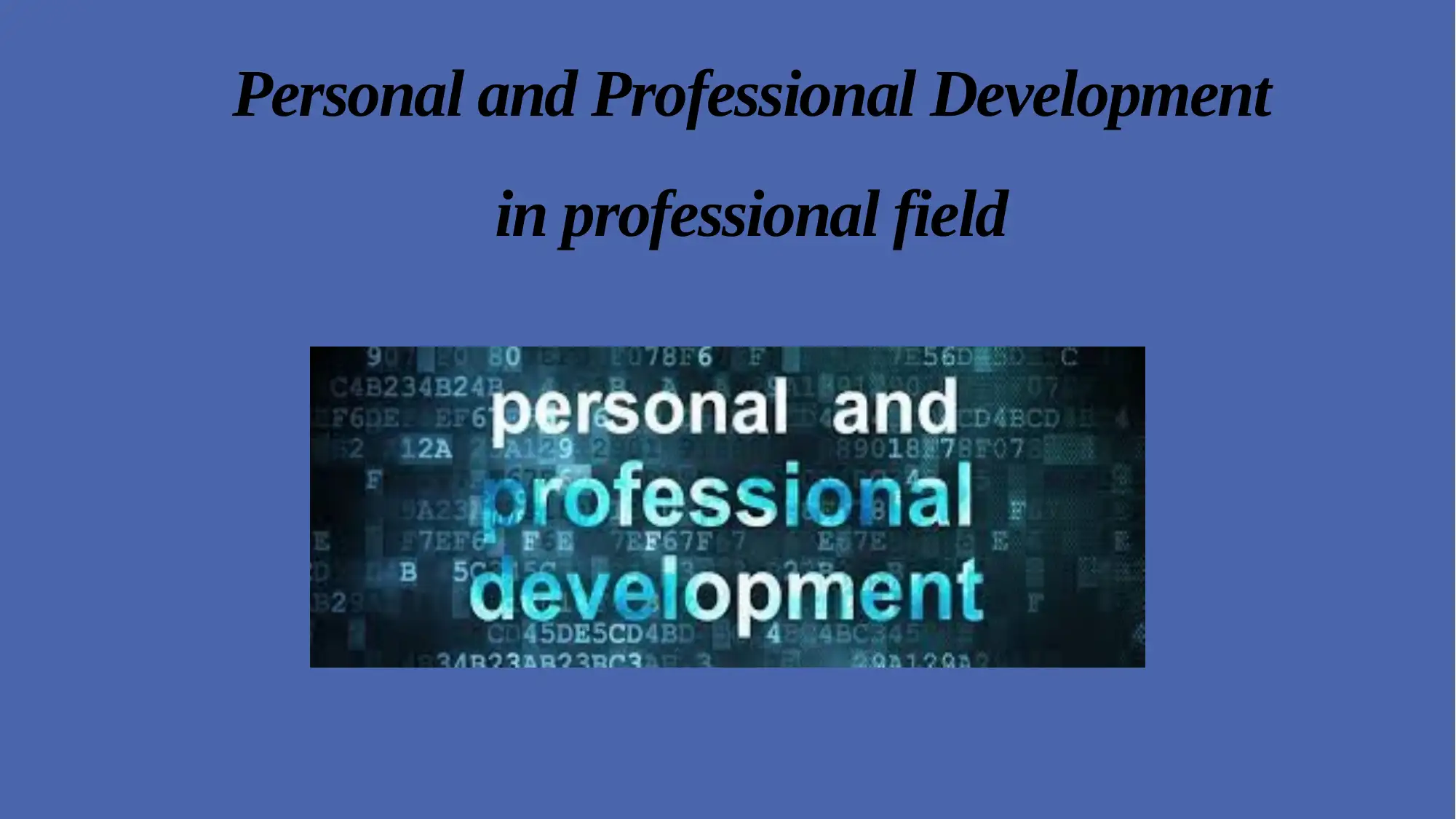
Personal and Professional Development
in professional field
in professional field
Secure Best Marks with AI Grader
Need help grading? Try our AI Grader for instant feedback on your assignments.
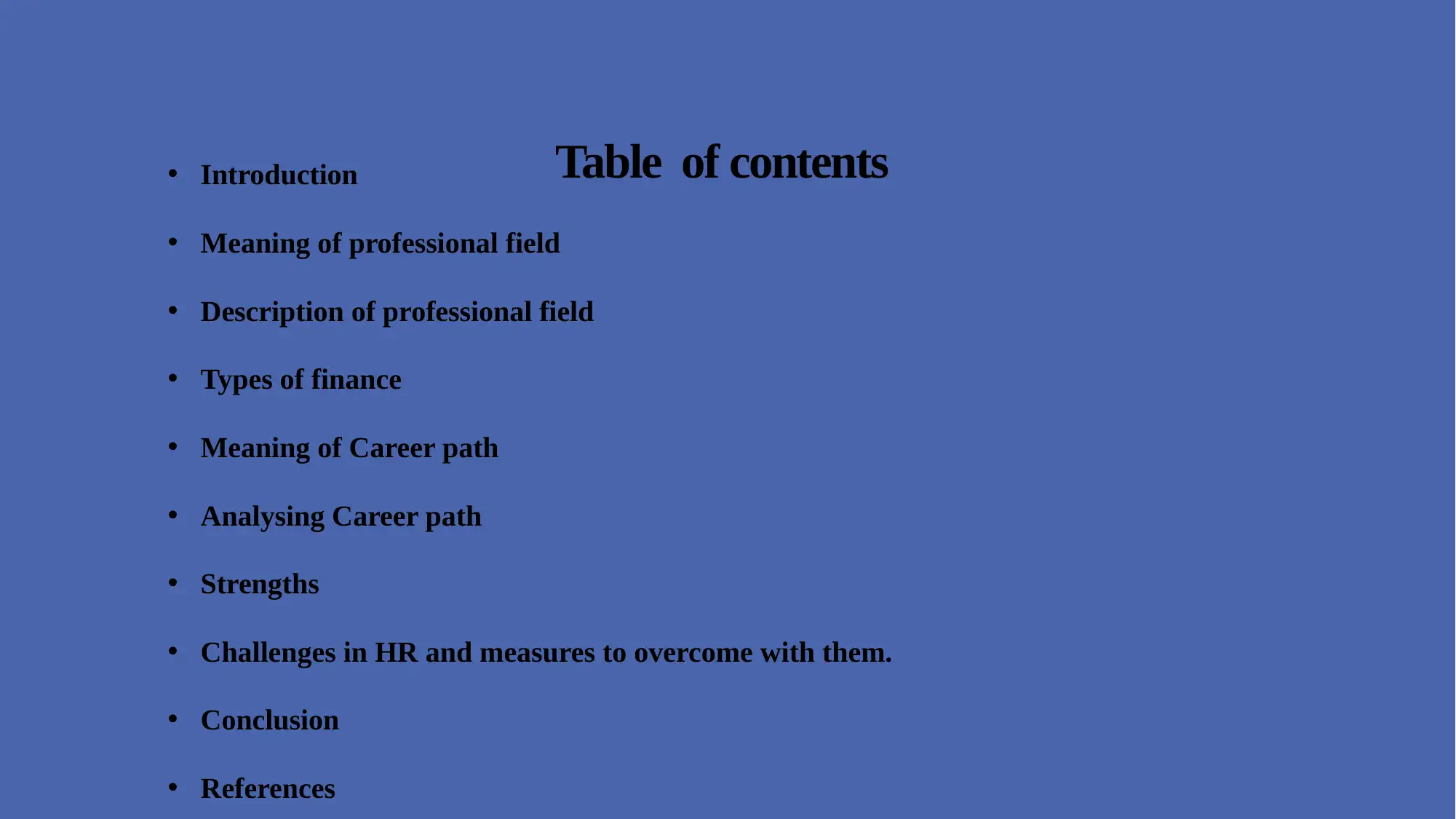
Table of contents• Introduction
• Meaning of professional field
• Description of professional field
• Types of finance
• Meaning of Career path
• Analysing Career path
• Strengths
• Challenges in HR and measures to overcome with them.
• Conclusion
• References
• Meaning of professional field
• Description of professional field
• Types of finance
• Meaning of Career path
• Analysing Career path
• Strengths
• Challenges in HR and measures to overcome with them.
• Conclusion
• References
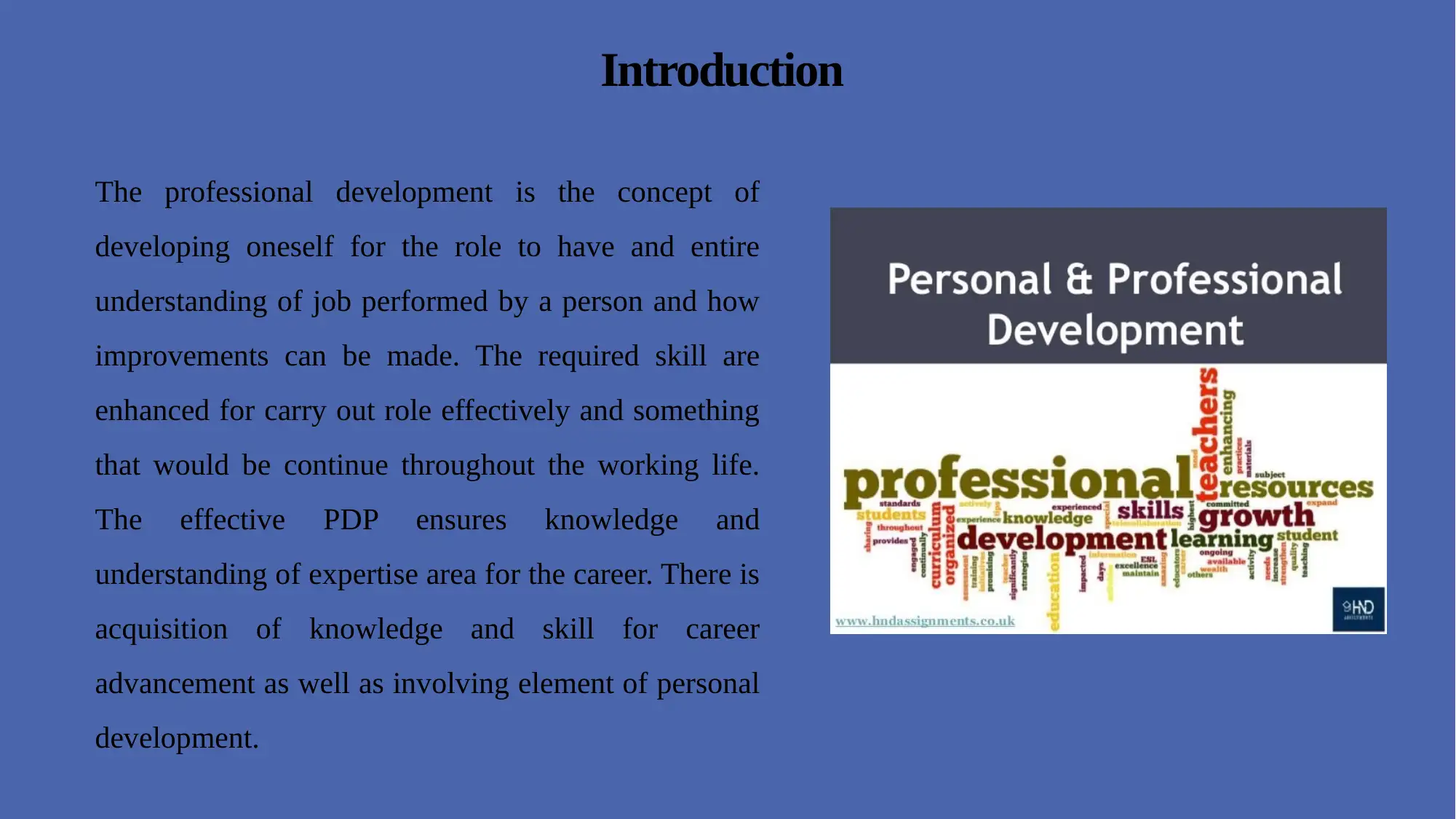
Introduction
The professional development is the concept of
developing oneself for the role to have and entire
understanding of job performed by a person and how
improvements can be made. The required skill are
enhanced for carry out role effectively and something
that would be continue throughout the working life.
The effective PDP ensures knowledge and
understanding of expertise area for the career. There is
acquisition of knowledge and skill for career
advancement as well as involving element of personal
development.
The professional development is the concept of
developing oneself for the role to have and entire
understanding of job performed by a person and how
improvements can be made. The required skill are
enhanced for carry out role effectively and something
that would be continue throughout the working life.
The effective PDP ensures knowledge and
understanding of expertise area for the career. There is
acquisition of knowledge and skill for career
advancement as well as involving element of personal
development.
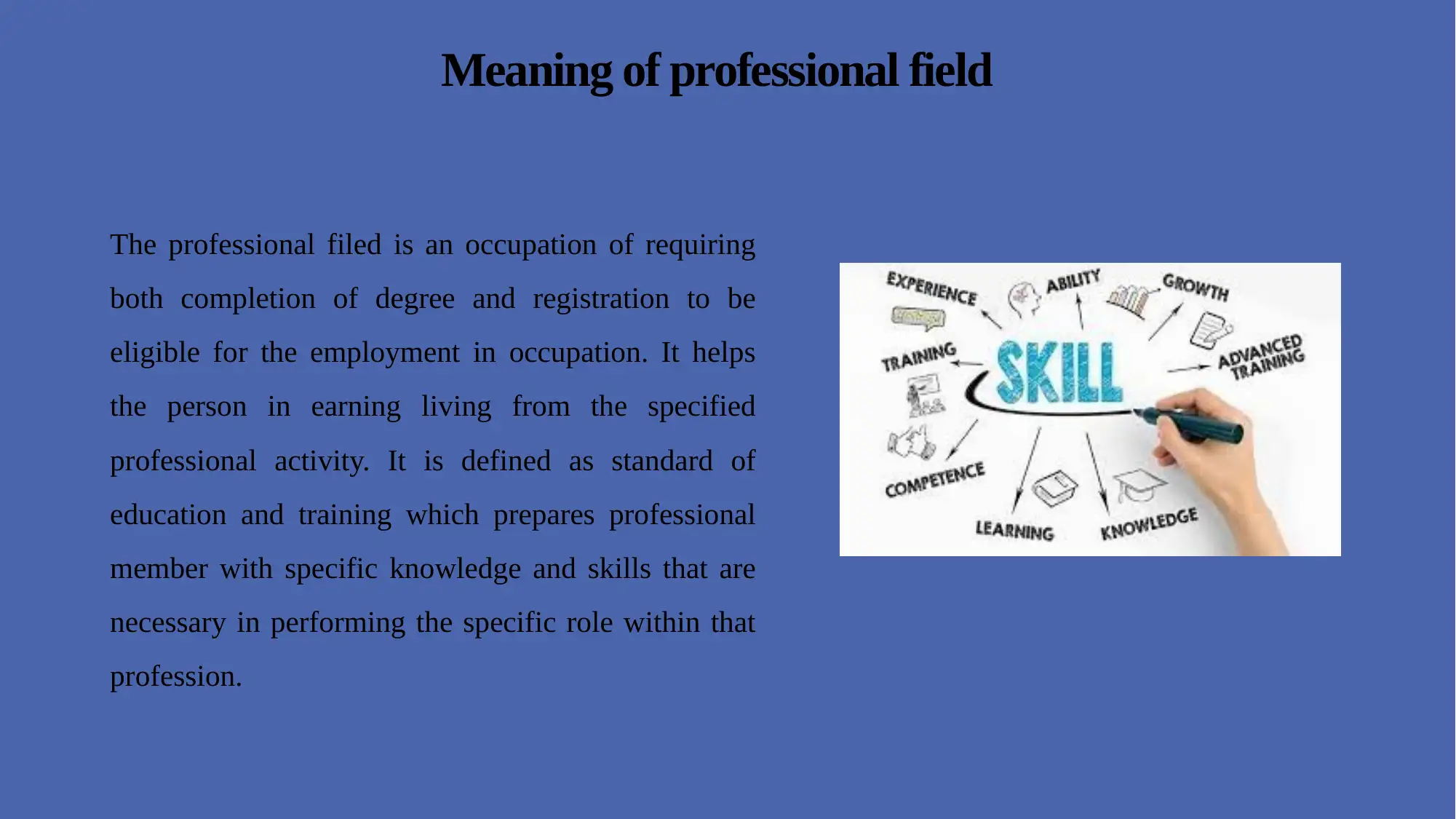
Meaning of professional field
The professional filed is an occupation of requiring
both completion of degree and registration to be
eligible for the employment in occupation. It helps
the person in earning living from the specified
professional activity. It is defined as standard of
education and training which prepares professional
member with specific knowledge and skills that are
necessary in performing the specific role within that
profession.
The professional filed is an occupation of requiring
both completion of degree and registration to be
eligible for the employment in occupation. It helps
the person in earning living from the specified
professional activity. It is defined as standard of
education and training which prepares professional
member with specific knowledge and skills that are
necessary in performing the specific role within that
profession.
Secure Best Marks with AI Grader
Need help grading? Try our AI Grader for instant feedback on your assignments.
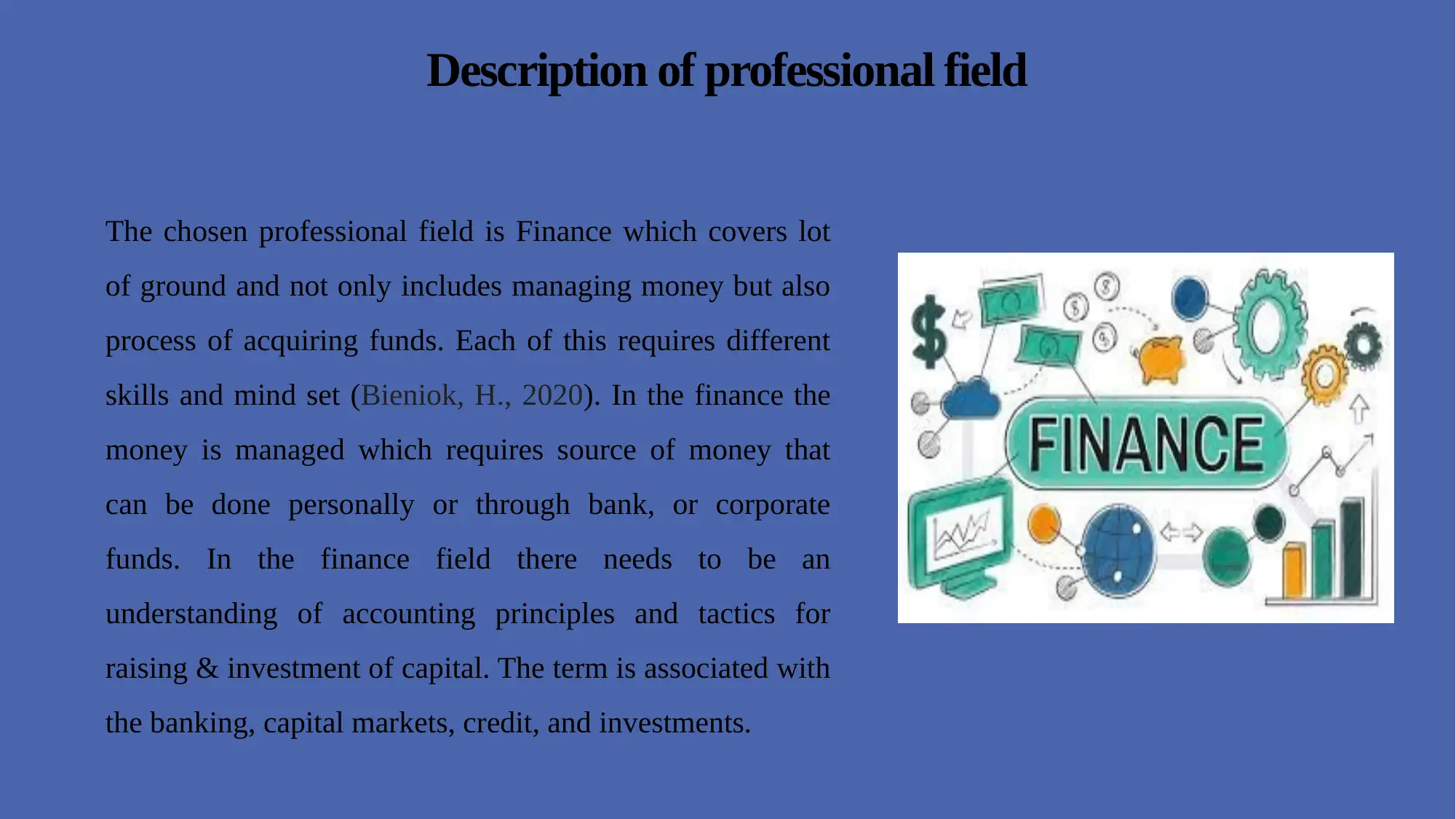
Description of professional field
The chosen professional field is Finance which covers lot
of ground and not only includes managing money but also
process of acquiring funds. Each of this requires different
skills and mind set (Bieniok, H., 2020). In the finance the
money is managed which requires source of money that
can be done personally or through bank, or corporate
funds. In the finance field there needs to be an
understanding of accounting principles and tactics for
raising & investment of capital. The term is associated with
the banking, capital markets, credit, and investments.
The chosen professional field is Finance which covers lot
of ground and not only includes managing money but also
process of acquiring funds. Each of this requires different
skills and mind set (Bieniok, H., 2020). In the finance the
money is managed which requires source of money that
can be done personally or through bank, or corporate
funds. In the finance field there needs to be an
understanding of accounting principles and tactics for
raising & investment of capital. The term is associated with
the banking, capital markets, credit, and investments.
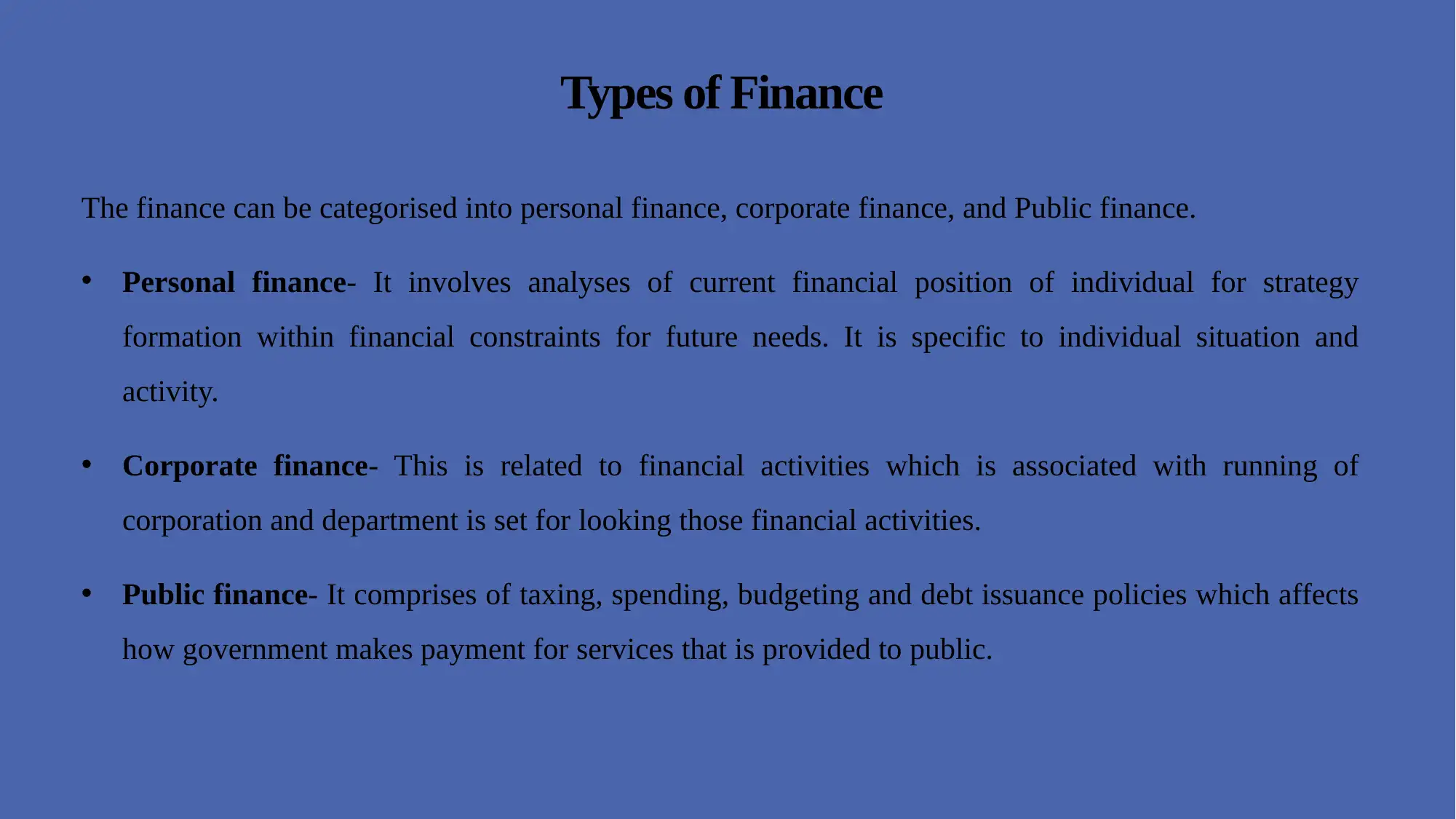
Types of Finance
The finance can be categorised into personal finance, corporate finance, and Public finance.
• Personal finance- It involves analyses of current financial position of individual for strategy
formation within financial constraints for future needs. It is specific to individual situation and
activity.
• Corporate finance- This is related to financial activities which is associated with running of
corporation and department is set for looking those financial activities.
• Public finance- It comprises of taxing, spending, budgeting and debt issuance policies which affects
how government makes payment for services that is provided to public.
The finance can be categorised into personal finance, corporate finance, and Public finance.
• Personal finance- It involves analyses of current financial position of individual for strategy
formation within financial constraints for future needs. It is specific to individual situation and
activity.
• Corporate finance- This is related to financial activities which is associated with running of
corporation and department is set for looking those financial activities.
• Public finance- It comprises of taxing, spending, budgeting and debt issuance policies which affects
how government makes payment for services that is provided to public.
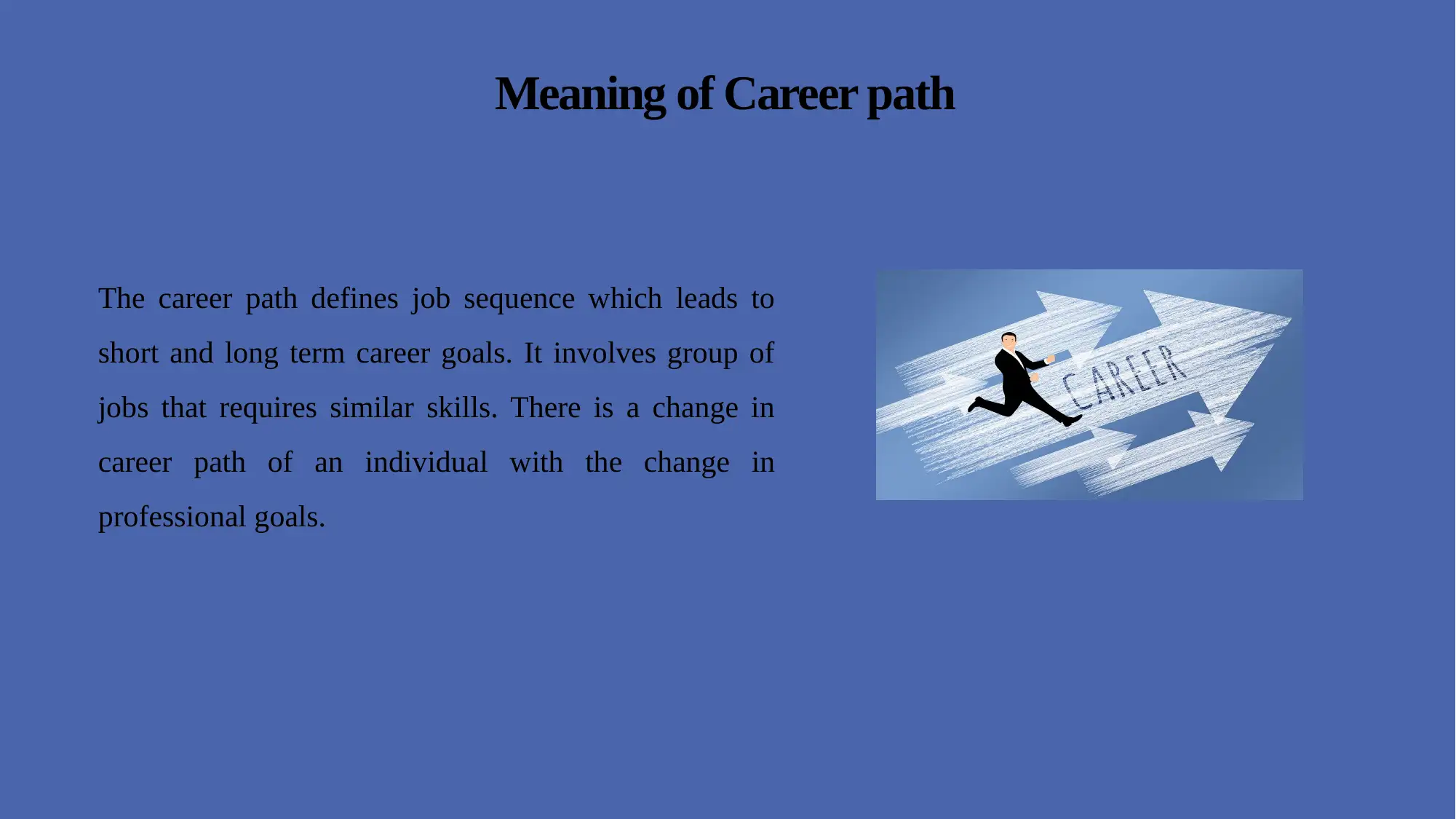
Meaning of Career path
The career path defines job sequence which leads to
short and long term career goals. It involves group of
jobs that requires similar skills. There is a change in
career path of an individual with the change in
professional goals.
The career path defines job sequence which leads to
short and long term career goals. It involves group of
jobs that requires similar skills. There is a change in
career path of an individual with the change in
professional goals.
Paraphrase This Document
Need a fresh take? Get an instant paraphrase of this document with our AI Paraphraser
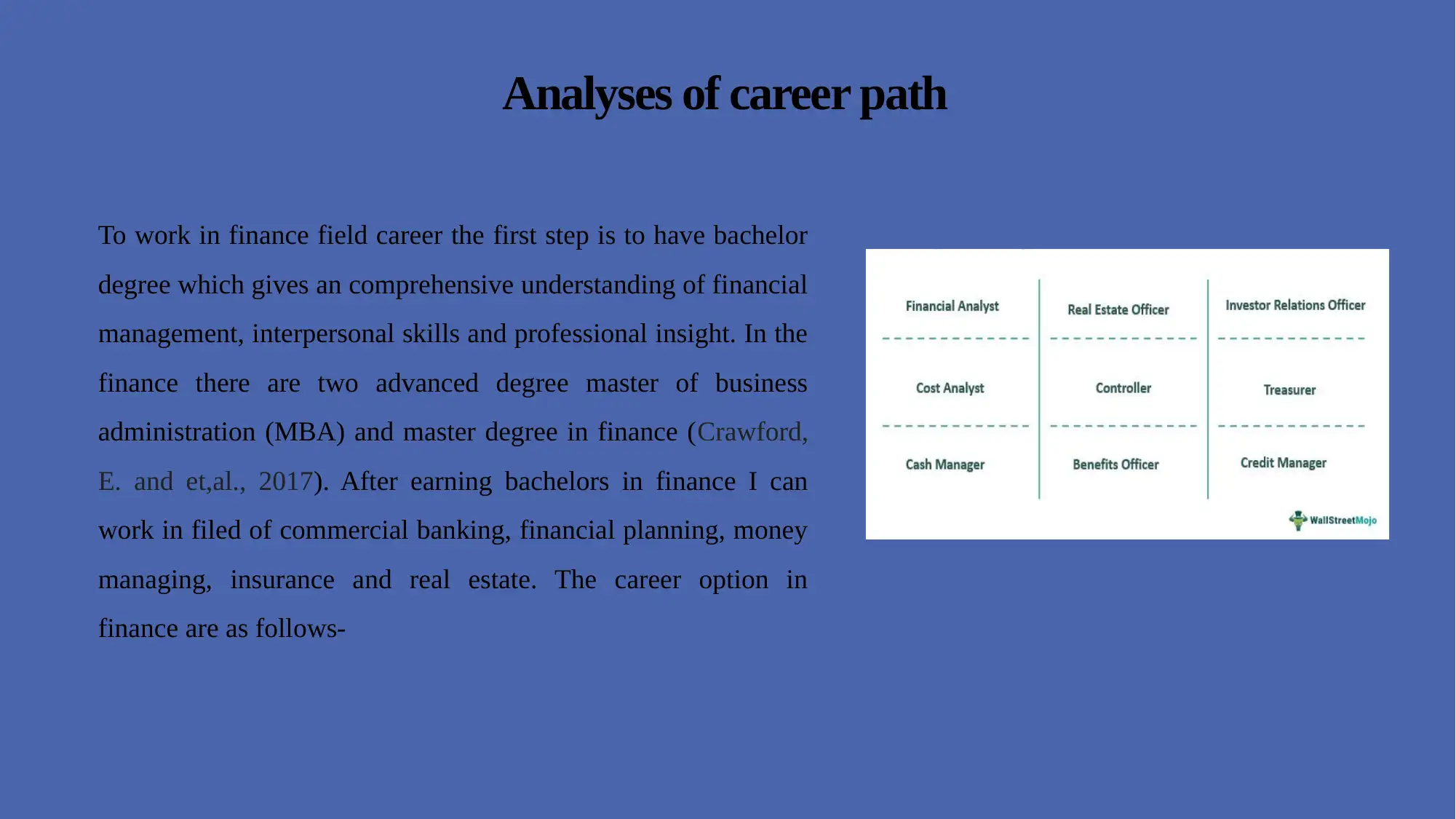
Analyses of career path
To work in finance field career the first step is to have bachelor
degree which gives an comprehensive understanding of financial
management, interpersonal skills and professional insight. In the
finance there are two advanced degree master of business
administration (MBA) and master degree in finance (Crawford,
E. and et,al., 2017). After earning bachelors in finance I can
work in filed of commercial banking, financial planning, money
managing, insurance and real estate. The career option in
finance are as follows-
To work in finance field career the first step is to have bachelor
degree which gives an comprehensive understanding of financial
management, interpersonal skills and professional insight. In the
finance there are two advanced degree master of business
administration (MBA) and master degree in finance (Crawford,
E. and et,al., 2017). After earning bachelors in finance I can
work in filed of commercial banking, financial planning, money
managing, insurance and real estate. The career option in
finance are as follows-
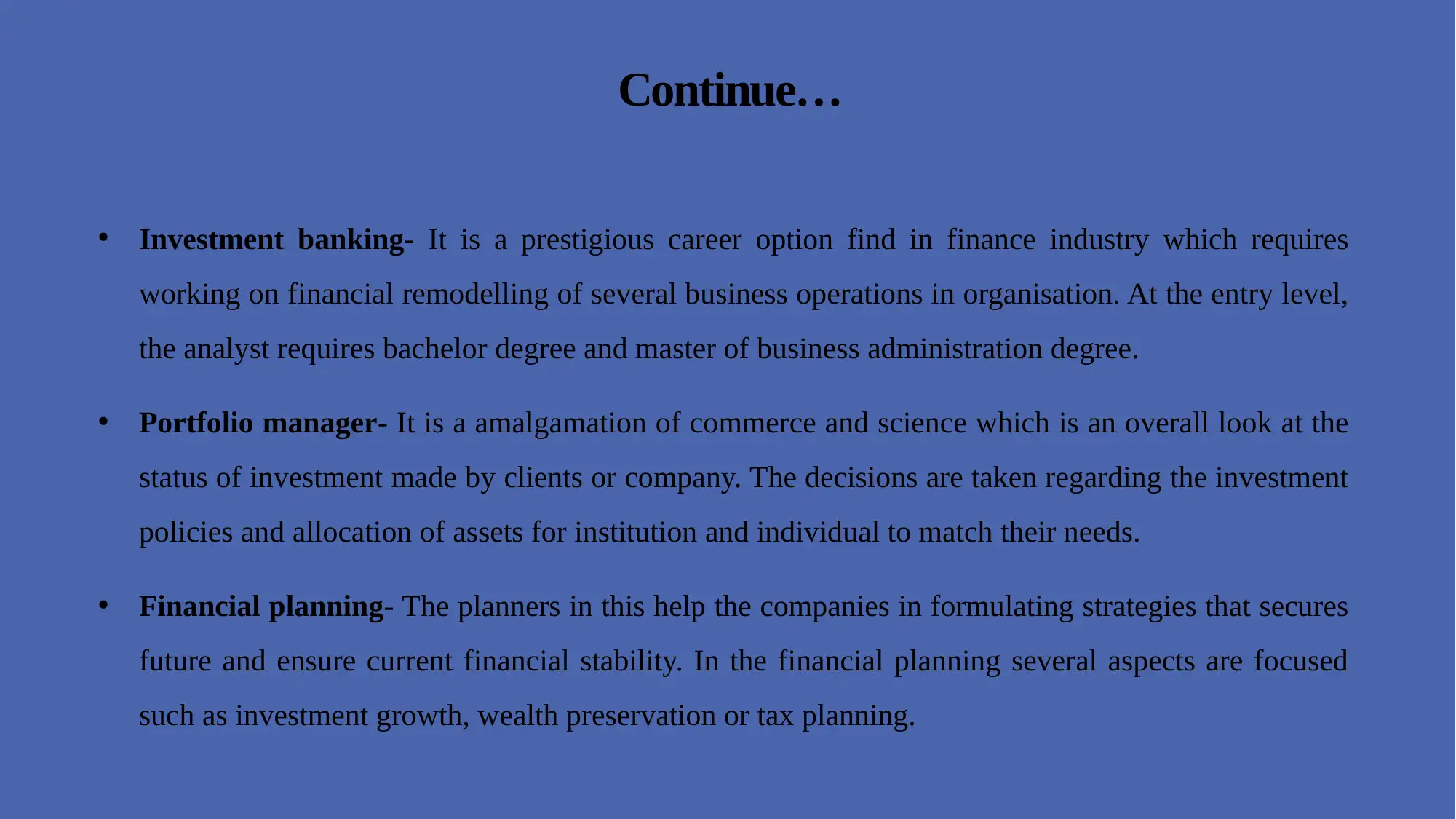
Continue…
• Investment banking- It is a prestigious career option find in finance industry which requires
working on financial remodelling of several business operations in organisation. At the entry level,
the analyst requires bachelor degree and master of business administration degree.
• Portfolio manager- It is a amalgamation of commerce and science which is an overall look at the
status of investment made by clients or company. The decisions are taken regarding the investment
policies and allocation of assets for institution and individual to match their needs.
• Financial planning- The planners in this help the companies in formulating strategies that secures
future and ensure current financial stability. In the financial planning several aspects are focused
such as investment growth, wealth preservation or tax planning.
• Investment banking- It is a prestigious career option find in finance industry which requires
working on financial remodelling of several business operations in organisation. At the entry level,
the analyst requires bachelor degree and master of business administration degree.
• Portfolio manager- It is a amalgamation of commerce and science which is an overall look at the
status of investment made by clients or company. The decisions are taken regarding the investment
policies and allocation of assets for institution and individual to match their needs.
• Financial planning- The planners in this help the companies in formulating strategies that secures
future and ensure current financial stability. In the financial planning several aspects are focused
such as investment growth, wealth preservation or tax planning.

Continue…
Financial analyst-In this the analyst are responsible for researching potential investment and opinions
& recommendations are offered for helping & guiding traders and portfolio managers.
Stock broking- After the study of finance it is also an highly respected and lucrative career option
where stock brokers studies stock and stock market conditions. The brokers also provide advice on
stocks to which they must buy to suit their needs.
Financial analyst-In this the analyst are responsible for researching potential investment and opinions
& recommendations are offered for helping & guiding traders and portfolio managers.
Stock broking- After the study of finance it is also an highly respected and lucrative career option
where stock brokers studies stock and stock market conditions. The brokers also provide advice on
stocks to which they must buy to suit their needs.
Secure Best Marks with AI Grader
Need help grading? Try our AI Grader for instant feedback on your assignments.

Identification of Strength and linked with career path
To have career in the field of Finance the strength required are-
• I have strength of analytical thinking by which I have understanding to interpret situation and
problems are solved from technical to interpersonal. The smart solutions can be provided to
company which will help me in the career path of Financial analyst.
• I poses strength of accounting skill by which I can track, record and manage financial transactions
efficiently and effectively. I can perform financial analysis, financial modelling and helping me in
the career path of investment banking and financial planning (Hildebrand, J., 2018).
• The strength of business intelligence will help me in career path of Financial analyst by making
smart decisions.
To have career in the field of Finance the strength required are-
• I have strength of analytical thinking by which I have understanding to interpret situation and
problems are solved from technical to interpersonal. The smart solutions can be provided to
company which will help me in the career path of Financial analyst.
• I poses strength of accounting skill by which I can track, record and manage financial transactions
efficiently and effectively. I can perform financial analysis, financial modelling and helping me in
the career path of investment banking and financial planning (Hildebrand, J., 2018).
• The strength of business intelligence will help me in career path of Financial analyst by making
smart decisions.
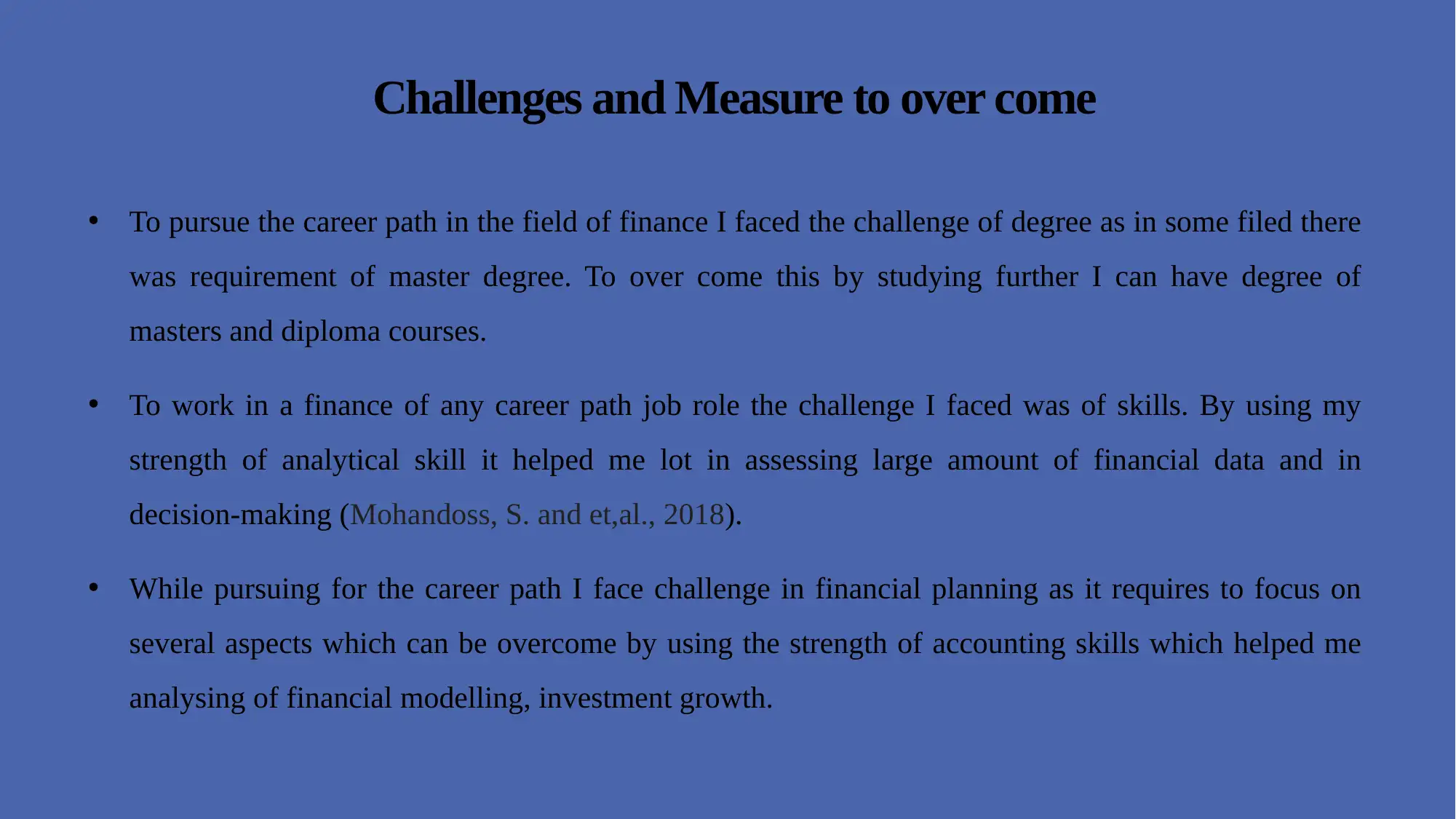
Challenges and Measure to over come
• To pursue the career path in the field of finance I faced the challenge of degree as in some filed there
was requirement of master degree. To over come this by studying further I can have degree of
masters and diploma courses.
• To work in a finance of any career path job role the challenge I faced was of skills. By using my
strength of analytical skill it helped me lot in assessing large amount of financial data and in
decision-making (Mohandoss, S. and et,al., 2018).
• While pursuing for the career path I face challenge in financial planning as it requires to focus on
several aspects which can be overcome by using the strength of accounting skills which helped me
analysing of financial modelling, investment growth.
• To pursue the career path in the field of finance I faced the challenge of degree as in some filed there
was requirement of master degree. To over come this by studying further I can have degree of
masters and diploma courses.
• To work in a finance of any career path job role the challenge I faced was of skills. By using my
strength of analytical skill it helped me lot in assessing large amount of financial data and in
decision-making (Mohandoss, S. and et,al., 2018).
• While pursuing for the career path I face challenge in financial planning as it requires to focus on
several aspects which can be overcome by using the strength of accounting skills which helped me
analysing of financial modelling, investment growth.
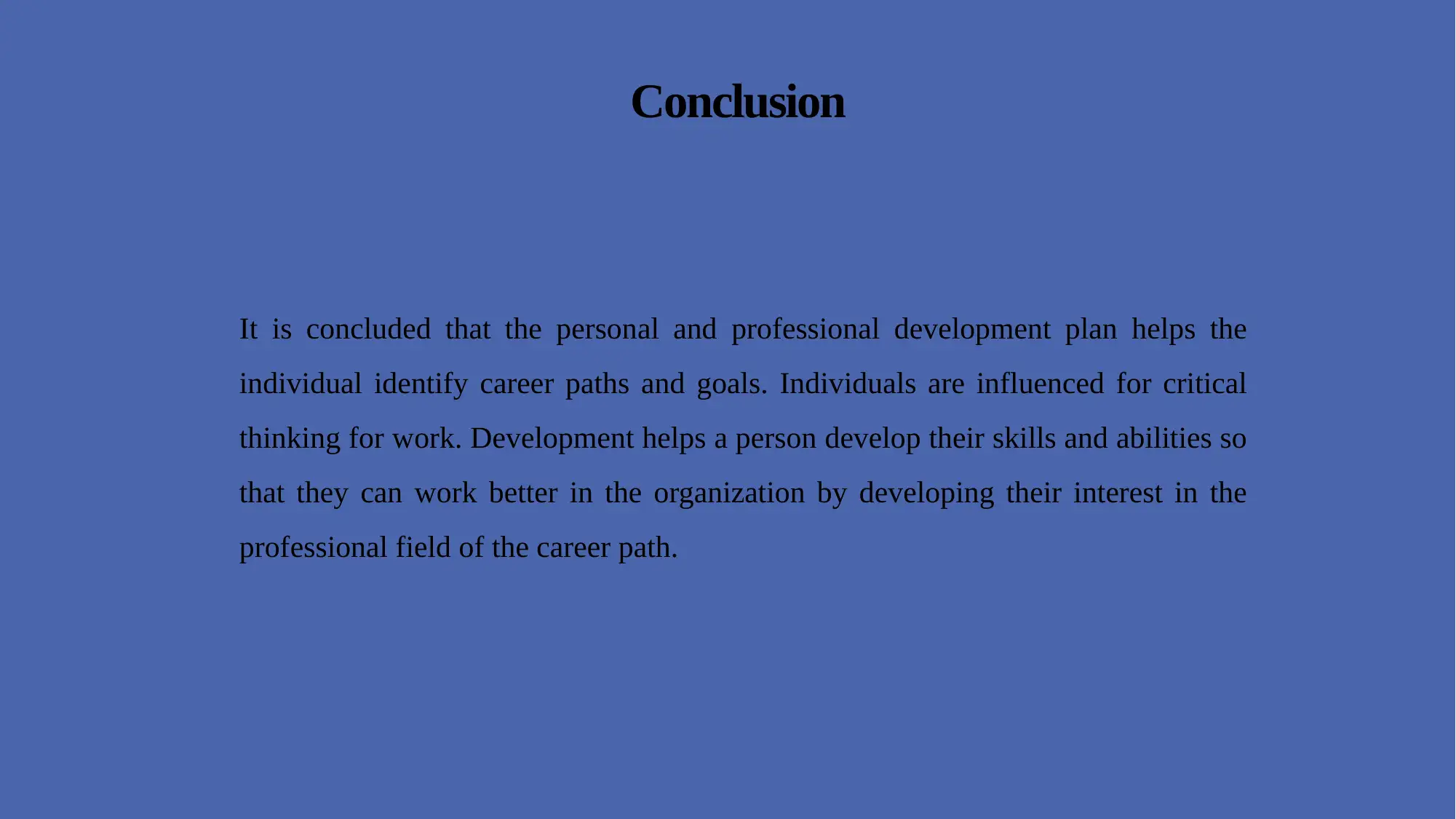
Conclusion
It is concluded that the personal and professional development plan helps the
individual identify career paths and goals. Individuals are influenced for critical
thinking for work. Development helps a person develop their skills and abilities so
that they can work better in the organization by developing their interest in the
professional field of the career path.
It is concluded that the personal and professional development plan helps the
individual identify career paths and goals. Individuals are influenced for critical
thinking for work. Development helps a person develop their skills and abilities so
that they can work better in the organization by developing their interest in the
professional field of the career path.
Paraphrase This Document
Need a fresh take? Get an instant paraphrase of this document with our AI Paraphraser

References
• Mikhaylov, N.S., 2018. Development of Personal Learning and Social Networks: Strategies for
Knowledge Creation and Sharing in Online Learning Environments. In On the Line (pp. 127-
139). Springer, Cham.
• Mohandoss, S. and et,al., 2018. Fractal based ultra-wideband antenna development for wireless
personal area communication applications. Aeu-International Journal of Electronics and
Communications.93. pp.95-102.
• Parodi, O. and Tamm, K., 2018. Personal sustainability: Exploring a new field of sustainable
development. In Personal Sustainability (pp. 1-17). Routledge.
• Staben, M. and et,al., 2021. Development of an Anesthesiology Disaster Response
Plan. Anesthesiology clinics. 39(2). pp.245-253.
• Mikhaylov, N.S., 2018. Development of Personal Learning and Social Networks: Strategies for
Knowledge Creation and Sharing in Online Learning Environments. In On the Line (pp. 127-
139). Springer, Cham.
• Mohandoss, S. and et,al., 2018. Fractal based ultra-wideband antenna development for wireless
personal area communication applications. Aeu-International Journal of Electronics and
Communications.93. pp.95-102.
• Parodi, O. and Tamm, K., 2018. Personal sustainability: Exploring a new field of sustainable
development. In Personal Sustainability (pp. 1-17). Routledge.
• Staben, M. and et,al., 2021. Development of an Anesthesiology Disaster Response
Plan. Anesthesiology clinics. 39(2). pp.245-253.

Thank you
1 out of 15
Related Documents
Your All-in-One AI-Powered Toolkit for Academic Success.
+13062052269
info@desklib.com
Available 24*7 on WhatsApp / Email
![[object Object]](/_next/static/media/star-bottom.7253800d.svg)
Unlock your academic potential
© 2024 | Zucol Services PVT LTD | All rights reserved.





